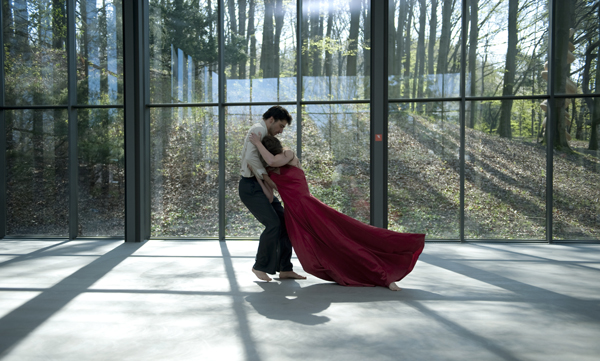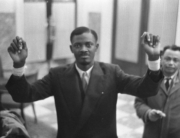Pina opens at the proscenium stage of the Wuppertal Theater in western Germany and then quickly plunges the audience into the imagination of choreographer Pina Bausch, who created unique indoor and outdoor “tanztheater” (dance theater) there for 36 years, beginning in 1973.
Director Wim Wenders wanted to film her avant-garde work even before they became friends in the 1980s. However, until Catherine Owens and Mark Pellington’s concert film U2-3D (2007) and James Cameron’s Avatar (2009) came along, he felt film technology couldn’t get fully around the movement in her work. Moving 3D beyond the realm of science fiction and rock ‘n’ roll, he had to work with specialists to develop more maneuverable cameras, for both close ups and widescreen shots, that could capture the changing speeds of her Tanztheater Wuppertal ensemble as they rehearsed a retrospective of her major works in June 2009. She died days before shooting was scheduled to start. So instead of the initially planned collaboration between Wenders and Bausch, the film is a loving memorial by her dancers and colleagues. Beyond a nostalgic tribute for the cognoscenti, this visually stunning film is a terrific introduction for those of us who never saw her or her troupe perform under her direction. It will be an essential educational resource (and inspiration) for future dance fans.
Four of her major pieces were filmed indoors live in the theater, some in front of an audience. Café Müller (1978), set to music by Henry Purcell, is the most deceptively minimalist as five dancers, moving like they are blind or spellbound, are guided by another dancer through an obstacle course of coffee tables and chairs. Kontakthof (translated as “House of Contact”) puts the focus on Bausch’s choreography on many body types. Set to popular songs of the 1930s, the dance hall-like setting first features ensemble members, then senior citizens, teenagers, and back and forth, like cinematic flashbacks and flash-forwards through time.
Interspersed throughout the documentary are oral history interviews with her dancers. Their many languages speak to the powerful draw of her work, each recalling the thrill of being accepted into her company. Many demonstrate the solo pieces she created for them, which illustrate her choreographic methods and the ensuing aches and pains. (Everything is not beautiful at this ballet, as sung in A Chorus Line). Their memories are supplemented with Bausch’s voice and brief black-and-white archival rehearsal scenes, reprocessed into 3D. The aging of dancers, particularly the bodies of those who started out with her decades ago, are a particular theme. As they matured, she cast them in matriarchal and patriarchal roles, like in the primal mythic community of Das Frühlingsopfer, created in 1975 to Igor Stravinsky’s The Rite of Spring ballet score, and infamous for the tons of dirt tracked through on the stage. Vollmond (Full Moon) (2006) also brings nature indoors. Set to a wide ranging score, 12 dancers are storm-tossed in a rocky, mountainous setting with a huge onstage waterfall and a moat-like river.
Even more visually thrilling are the outdoor dances that dramatically show off Bausch’s ground-breaking site-specific choreography and blaze new paths in the use of 3D, setting the mark that future movie musicals will have to surpass. Dancers move from sylvan scenes of meadows to gritty urban streets and onto a monorail car of the Wuppertal Schwebebahn suspension railway.
As strikingly beautiful as the images and the enthusiasm of the dancers are, it is maddening to the point of confusing distraction that the interviewees and the outdoor pieces are not clearly identified on screen, just listed in the concluding credit roll. This seems particularly dishonorable to the older dancers, who collaborated for so long and so creatively with the choreographer. Regardless, Pina can be a welcome alternative from repeat viewings of The Nutcracker this holiday season. Kids who can read the subtitles can probably deal with a documentary rated PG “for some sensuality and smoking.” These exciting dancers could astronomically expand younger viewers’ horizons from Glee or more conventional TV competitions and spark a flame for a very different dance.







If I could be born againg and start life from the begining…I’d do it just to become a contemporary dancer…and create such WONDERFUL Works as these!!
simply moved me. Purely truth-art. i loved it…i lived it trough my eyes while i was watching this vídeo.
Thanks